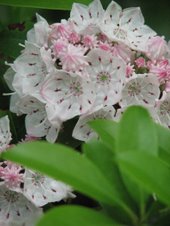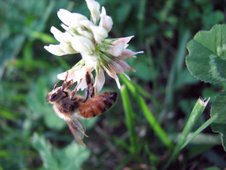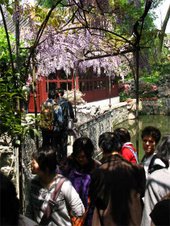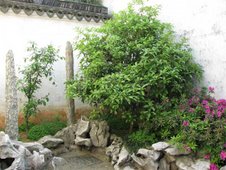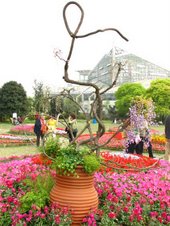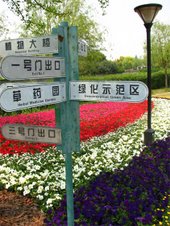The Panicled Aster or Eastern Lined Aster is a member of the large family Asteraceae. The Latin names are “Aster lanceolantus” and “Aster simplex”). Aster is a Greek word for star which describes the radiate heads of the flowers. The Latin word “lanceolatus” means lance-shaped which describes the long thin leaves. The plant is commonly found along wet stream banks in wooded areas and can grow in good and poor soil. I found this still blooming plant two day ago growing on the bank of our driveway under cedar trees. Even though the plant has lovely white daisy-like flowers it is considered a pesky weed.
The Panicled Aster can be distinguished from its other numerous family members because it blooms in autumn from September to November. The flowers are smaller than a quarter, around ¾ inches across. The white flower petals, which number 20-40, are white and curl up as the flower dies. The white or sometimes violet tinged petals surround a yellow center which turns brown from age. This perennial prefers partial sun and grows from one to 3 feet tall. The alternate leaves are smooth or slightly toothed along the leaf edge.
The Aster family contains 20,000 species worldwide. It and the Orchid family are the two largest plant families. Asteraceae has been known as the daisy or sunflower family (Compositae). Several members of the Aster family have been used historically and are presently used as medicine and food. The Eastern Lined Aster was used by the Native American tribe Mohawk for treating fever.
Native Aster plants need little care, bear lovely flowers, and attract butterflies.
Roaming the internet I came across Thomas Elpel’s fascinating description of Asteraceae. The uniqueness of this family is that what appears to be a single flower are many flowers. This is easier observed in a sunflower head than in the small flower of the Eastern Lined Aster. If I had a magnifying glass with me you could view the many flowers in the yellow head of the Eastern Lined Aster.
Many species of Asters have been developed into horticultural ornamentals such as marigold, Zinnias, etc. Other species have been developed into edibles, such as, artichokes, sunflower, etc.
The Aster family can be divided into a Dandelion Subfamily and an Aster Subfamily. Under the Aster Subfamily are nine tribes. Some of them are the Artichoke Tribe, Ragweed tribe, Chamonile Tribe etc.
This is amazing but a little confusing so I will stop for now.
Wednesday, November 16, 2011
Thursday, October 20, 2011
Tufted Knotweed
The wild flower called Tufted Knotweed (Polygonum caespitosum var.longisetum) or long-bristled smartweed is in the buckwheat family (Polygonaceae), which is also known as the knotweed family. Polygonum is Greek for many knees or many joints.
Leaves are arranged alternately along the stem, lanceolate to elliptic in outline, approximately 3/4 to 3 inches long and 1/2 to 1 1/4 inches wide. Older leaves are usually only slightly hairy. The leaves taper to short petioles, which have an ocrea which encircles the stem. Leaves often, but not always, have a purple spot in the middle of the leaf.
Knotweed has fibrous roots with a shallow and branching taproot. The stems are branched, often reddish in color and swollen at the nodes. A thin membranous sheath called an ocrea encircles the stem at the base of each leaf petiole. The ocrea's of tufted knotweed have stiff hairs arising from the top of the ocrea, which are from 5 to 10 mm long.
The blooming period occurs during the summer and early fall, and can last 2-3 months for a colony of plants. Flowers are clustered in terminal spikes at the ends of stems. Individual flowers are small and are dark pink to red in color. Each flower is replaced by a 3-angled seed that is black and shiny, tapering to blunt points at the upper and lower ends. This plant can reproduce by forming rootlets near the ochreae of the leaves. It also reproduces by reseeding itself.
This weedy plant isn't fussy about growing conditions. It can be found in full sun to light shade, moist to dry areas, and various kinds of soil, including those containing loam, clay loam, and rocky or gravelly material. Some of the lower leaves may shrivel away during hot dry weather. This smartweed withstands regular lawn-mowing better than others because of its low-growing habit.
There are about 35 species of smartweeds found in the east. Three smartweeds in our area are similar except for the stiff hairs on the ocrea or knee. The elliptic to lanceolate leaves with a purple spotted 'lady's thumb' print in the middle and distinctive ocrea with stiff hairs are all characteristics that help to distinguish tufted knotweed from other similar weeds. Pennsylvania Smartweed (Polygonum pensylvanicum) is very similar in appearance and growth habit, but does not have hairs on the knee like that of tufted knotweed. Lady’s Thumb (Polygonum persicaria) is also similar in appearance and growth habit, but has hairs on the knee that are much shorter (2 mm) and has generally smaller leaves and dark pink to red flowers.
As a wildflower smartweeds are a lovely blooming addition to your yard. Birds that eat the seeds of the Smartweeds include the Mourning Dove, English Sparrow, House Finch, other songbirds, and ducks.
Leaves, stems and flowers are edible, but very hot. Try a small part of leave about ¼ size of your little finger nail. Wait a second or 2 then you will taste the heat. Good substitute for pepper or wasabi in your cooking, but use sparingly. The plant can be used fresh or dried. It’s a fine plant for seasoning while camp cooking, but can overwhelm like cayenne pepper. Also be careful because some people can develop dermatitis from it.
There is a tradition, quoted in old Herbals, that if a handful of the plant be placed under the saddle, a horse is enabled to travel for some time without becoming hungry or thirst.
Leaves are arranged alternately along the stem, lanceolate to elliptic in outline, approximately 3/4 to 3 inches long and 1/2 to 1 1/4 inches wide. Older leaves are usually only slightly hairy. The leaves taper to short petioles, which have an ocrea which encircles the stem. Leaves often, but not always, have a purple spot in the middle of the leaf.
Knotweed has fibrous roots with a shallow and branching taproot. The stems are branched, often reddish in color and swollen at the nodes. A thin membranous sheath called an ocrea encircles the stem at the base of each leaf petiole. The ocrea's of tufted knotweed have stiff hairs arising from the top of the ocrea, which are from 5 to 10 mm long.
The blooming period occurs during the summer and early fall, and can last 2-3 months for a colony of plants. Flowers are clustered in terminal spikes at the ends of stems. Individual flowers are small and are dark pink to red in color. Each flower is replaced by a 3-angled seed that is black and shiny, tapering to blunt points at the upper and lower ends. This plant can reproduce by forming rootlets near the ochreae of the leaves. It also reproduces by reseeding itself.
This weedy plant isn't fussy about growing conditions. It can be found in full sun to light shade, moist to dry areas, and various kinds of soil, including those containing loam, clay loam, and rocky or gravelly material. Some of the lower leaves may shrivel away during hot dry weather. This smartweed withstands regular lawn-mowing better than others because of its low-growing habit.
There are about 35 species of smartweeds found in the east. Three smartweeds in our area are similar except for the stiff hairs on the ocrea or knee. The elliptic to lanceolate leaves with a purple spotted 'lady's thumb' print in the middle and distinctive ocrea with stiff hairs are all characteristics that help to distinguish tufted knotweed from other similar weeds. Pennsylvania Smartweed (Polygonum pensylvanicum) is very similar in appearance and growth habit, but does not have hairs on the knee like that of tufted knotweed. Lady’s Thumb (Polygonum persicaria) is also similar in appearance and growth habit, but has hairs on the knee that are much shorter (2 mm) and has generally smaller leaves and dark pink to red flowers.
As a wildflower smartweeds are a lovely blooming addition to your yard. Birds that eat the seeds of the Smartweeds include the Mourning Dove, English Sparrow, House Finch, other songbirds, and ducks.
Leaves, stems and flowers are edible, but very hot. Try a small part of leave about ¼ size of your little finger nail. Wait a second or 2 then you will taste the heat. Good substitute for pepper or wasabi in your cooking, but use sparingly. The plant can be used fresh or dried. It’s a fine plant for seasoning while camp cooking, but can overwhelm like cayenne pepper. Also be careful because some people can develop dermatitis from it.
There is a tradition, quoted in old Herbals, that if a handful of the plant be placed under the saddle, a horse is enabled to travel for some time without becoming hungry or thirst.
Monday, October 3, 2011
Weed or Miracle Plant?
Plantain is a perennial herb with basal leaves and
inconspicuous flowers in spikes or heads.
These wildflowers probably can be found in everyone’s yard or
field. The plant was introduced into the
new world by colonist from Europe. So it
first common names were “Englishman’s foot” or “White Man’s Foot”. The most common species in North America are Plantain major, the broad-leaved or
common plantain, and Plantain lanceolat,
the narrow-leaved English plantain.
In the spring the plant sprouts from its taproots or seeds. From early summer to late fall leafless flower
stalks arise from the center of the rosette of leaves. The tiny flowers are greenish white and become
a seedpod of 10 to 20 seeds. Most people treat this plant as a weed; since
it grows everywhere in most soil and light conditions.
However to many this is a miracle plant. Native Americans used the powdered roots of
Plantain as anti-venom for rattlesnake bites and the plant earned the name of
“Snake Weed”. In Europe the plant was
used for skin diseases and bites.
The very young leaves can be used in salads or cooked as
greens. The larger older leaves are used
for tea. The leaves are high in beta carotene
(vitamin A), vitamin B1, riboflavin, calcium, and ascorbic acid (vitamin C).
The young flower stalks of common plantain may be eaten raw
or cooked and taste like asparagus. The
seeds may be added to food or ground into flour. You may be familiar with Metamucil. This laxative’s primary ingredient is from
the seeds of a related species (Plantain psyllium).
There are medical benefits from all parts of the plant. A tea made from the leaves or the whole plant
can treat lung disorders, stomach problems and skin diseases and
irritations. Chewing on a leaf not only
refreshes your breath, but may discourage your desire to smoke cigarettes.
According to the School of Pharmacy at the University of Oslo, Norway “the leaves have been used as a wound healing remedy for centuries
in almost all parts of the world and in the treatment of a number of diseases
apart from wound healing”. So, if you
are outside and receive a bug bite or sting; chew a leaf and place on your
sore.
Plantain ointment and Plantain extract may be ordered online
from several vitamin companies.
This plant also provides food for butterfly caterpillars,
rabbits, deer, grouse, and other birds.
I used to constantly remove some of my numerous Plantain
plants, keeping the larger ones, which are easier for me to grow than the
flamboyant slug attractant Hosta. I look
forward to this coming spring when I will be picking the young Plantain leaves
for a salad.
Monday, February 21, 2011
Flora of Galapagos Islands
The Galapagos Archipelago is a volcanic group of islands in the East Pacific Ocean. About 97% of the islands comprise the Galapagos National Park which is surrounded by a Marine Reserve. I visited during the Hot Season which lasts from December until May. This is the tropical time of year with calm seas, tropical showers and warm humid days. Temperatures range from79 to 85F with water temperatures around79F.
Charles Darwin in 1835 developed the Theory of Natural Selection after his voyage to Galapagos on the H.M.S. Beagle. He observed new species which had developed due to environmental forces. Examples of these new species are Darwin’s finches, the Galapagos mockingbirds, the giant tortoises, the flightless cormorants, and the Galapagos penguins and cactus from the genus Opuntia and plants from the genus Scalesia. These new species were developed due to isolation (the Galapagos are 612 miles from South America continent), adaptations, and mutations which created a new species found nowhere else in the world. These new and unique species are called endemic.
Most well-known are the endemic bird and animal species, but there are also many endemic plant species. I will talk about a few of the endemic plants. The most notable are the cactus. There is an endemic Prickly Pear Cactus (Opuntia galapagensis) which has soft short spines. The fruits are eaten by finches, land iguanas and tortoises. Another endemic Prickly Pear Cactus is Opuntia echios var. Gigantea which has long sharp spines and can grow 5 feet tall. Marine iguanas and tortoises eat the fleshy part around the trunk of this cactus.
Growing in the lava fields is the Lava Cactus (Brachycereus Nesioticus). This small endemic cactus grows in clumps.
The Candelabra Cactus (Jasminocereus Thouarsil) is a large endemic cactus which grows to heights of 23 feet.
Mangrove swamps which cover the coastline of many islands provide food and shalter for many animals, birds, and marine species. The salt tolerant trees and shrubs thrive in shallow and muddy saltwater or brackish waters. Their root systems extend above the water and the vertical branches filter the salt out and allow the leaves to receive fresh water. The Black Mangrove (Avicennia germinans) has the highest salt tolerant leaves and grows to height of 65 feet. The Red Mangrove (Rhizophora mangle) is the most common in the Galapagos.
The Button Mangrove or Buttonwood (Conocarpus erecta) is not a true mangrove. The fruit buttons which dry to a brown color are used for decorations.
White Mangrove (Laguncularia racermosa) is a shrub with aerial roots close to the water.
Galapagos cotton (Gossypium darwinii) grows wild through many of the islands. The Muyuyo (Cordia Lutea) is an endemic tree with lovely yellow blooms.
In the Highlands the lowest of the humid zone is named for the daisy tree which grows between 970-1970 feet elevations. This endemic “daisy tree” has evolved into a host of different species in a direct parallel to the Darwin finches. The Scalesia is one of the few trees in the Aster Family and its trunk and branches are covered with moss, lichens and orchids.
This is a small example of the endemic plants which number around 200 plants. Galapagos plants are hardy plants which successfully cross oceans and manage to establish themselves in the often hostile environment of these volcanic islands.
Charles Darwin in 1835 developed the Theory of Natural Selection after his voyage to Galapagos on the H.M.S. Beagle. He observed new species which had developed due to environmental forces. Examples of these new species are Darwin’s finches, the Galapagos mockingbirds, the giant tortoises, the flightless cormorants, and the Galapagos penguins and cactus from the genus Opuntia and plants from the genus Scalesia. These new species were developed due to isolation (the Galapagos are 612 miles from South America continent), adaptations, and mutations which created a new species found nowhere else in the world. These new and unique species are called endemic.
Most well-known are the endemic bird and animal species, but there are also many endemic plant species. I will talk about a few of the endemic plants. The most notable are the cactus. There is an endemic Prickly Pear Cactus (Opuntia galapagensis) which has soft short spines. The fruits are eaten by finches, land iguanas and tortoises. Another endemic Prickly Pear Cactus is Opuntia echios var. Gigantea which has long sharp spines and can grow 5 feet tall. Marine iguanas and tortoises eat the fleshy part around the trunk of this cactus.
Growing in the lava fields is the Lava Cactus (Brachycereus Nesioticus). This small endemic cactus grows in clumps.
The Candelabra Cactus (Jasminocereus Thouarsil) is a large endemic cactus which grows to heights of 23 feet.
Mangrove swamps which cover the coastline of many islands provide food and shalter for many animals, birds, and marine species. The salt tolerant trees and shrubs thrive in shallow and muddy saltwater or brackish waters. Their root systems extend above the water and the vertical branches filter the salt out and allow the leaves to receive fresh water. The Black Mangrove (Avicennia germinans) has the highest salt tolerant leaves and grows to height of 65 feet. The Red Mangrove (Rhizophora mangle) is the most common in the Galapagos.
The Button Mangrove or Buttonwood (Conocarpus erecta) is not a true mangrove. The fruit buttons which dry to a brown color are used for decorations.
White Mangrove (Laguncularia racermosa) is a shrub with aerial roots close to the water.
Galapagos cotton (Gossypium darwinii) grows wild through many of the islands. The Muyuyo (Cordia Lutea) is an endemic tree with lovely yellow blooms.
In the Highlands the lowest of the humid zone is named for the daisy tree which grows between 970-1970 feet elevations. This endemic “daisy tree” has evolved into a host of different species in a direct parallel to the Darwin finches. The Scalesia is one of the few trees in the Aster Family and its trunk and branches are covered with moss, lichens and orchids.
This is a small example of the endemic plants which number around 200 plants. Galapagos plants are hardy plants which successfully cross oceans and manage to establish themselves in the often hostile environment of these volcanic islands.
The Galapagos National Park, Naturalist Guides, the Charles Darwin Research Station, and the people of the Galapagos strive to protect the Galapagos Archipelago. Rules of the National Park are to walk only on trails, do not disturb wildlife or remove plant or rock material, do not feed animals , do not smoke on islands or any boat, do not buy souvenirs made from native Galapagos species (except for wood). The Guides are there to educate guests and protect the environment. The locals and tourist ships recycle their plastics, glass, metal, and cardboard.
I traveled in the Galapagos with Mary Crowley. This was her eighteenth trip to the islands! She is the director of Ocean Voyages (http://www.oceanvoyages.com/), which places people on ships throughout the world..
Thursday, January 20, 2011
Another Frigid Month
I would like to start by quoting from my Jan. 2007 report. “No need to force blooms from your shrubs and trees this month. Due to our warm winter, daffodils, hellebores, daphne, forsythia, and cherry trees are already in bloom. Also, my Easter lilies are popping out of the soil and my flowering quince is flowering.”
Well that certainly isn’t happening this Jan.! The only good thought is that maybe this cold weather is killing all the nasty insects which harm our plants and us.
If the cold lingers on; then plan a visit to a garden show to uplift your spirits. The nation’s oldest floral show, the Philadelphia International Flower Show runs from Sunday March 6 through Sunday March 13. The theme for 2011 is “Springtime in Paris”.
The San Francisco Flower and Garden Show is March 23 through 27 at the San Mateo Event Center. Experience cutting-edge garden design, new plants, 200 vendors selling outdoor living products, 75 seminars and films. NEW this year is the "Garden To Table" cooking demonstrations with famous Bay Area chefs headlined by Alice Waters, 6000 sq. ft. of Edible Garden displays with hands-on advice, an expanded children's section, a wine garden, and a film premiere.
The Chelsea Flower Show 2011 dates are May 24 to 28 2011. The Chelsea Flower Show is one of the best known flower shows in the world. Run by the Royal Horticultural Society in England and takes place every May in the central London borough of Chelsea.
In spite of the weather the birds are gorging on seeds etc. and checking out bird houses in preparation for their future families.
In this cold weather cuddle up to a hot cup of tea. Peruse your garden books, seed catalogues, and dream of your future garden.
Well that certainly isn’t happening this Jan.! The only good thought is that maybe this cold weather is killing all the nasty insects which harm our plants and us.
If the cold lingers on; then plan a visit to a garden show to uplift your spirits. The nation’s oldest floral show, the Philadelphia International Flower Show runs from Sunday March 6 through Sunday March 13. The theme for 2011 is “Springtime in Paris”.
The San Francisco Flower and Garden Show is March 23 through 27 at the San Mateo Event Center. Experience cutting-edge garden design, new plants, 200 vendors selling outdoor living products, 75 seminars and films. NEW this year is the "Garden To Table" cooking demonstrations with famous Bay Area chefs headlined by Alice Waters, 6000 sq. ft. of Edible Garden displays with hands-on advice, an expanded children's section, a wine garden, and a film premiere.
The Chelsea Flower Show 2011 dates are May 24 to 28 2011. The Chelsea Flower Show is one of the best known flower shows in the world. Run by the Royal Horticultural Society in England and takes place every May in the central London borough of Chelsea.
In spite of the weather the birds are gorging on seeds etc. and checking out bird houses in preparation for their future families.
In this cold weather cuddle up to a hot cup of tea. Peruse your garden books, seed catalogues, and dream of your future garden.
Subscribe to:
Posts (Atom)






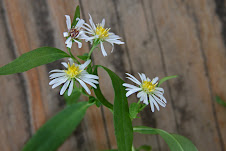












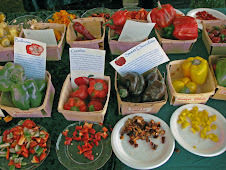LP_gardening_2666.jpg)
LP_gardening_2668.jpg)

LP_garden_2819.jpg)

LP_flower_0563.jpg)
LP_flower_0577.jpg)
LP_flower_0545.jpg)
LP_flower_0555.jpg)
LP_flower_0539.jpg)
LP_dog_0470.jpg)
LP_snow_0467.jpg)
LP_dog_0349.jpg)
LP_tree_8153.jpg)
LP_5028.jpg)
LP_flowers_3940.jpg)

LP-grass_0889.jpg)
LP_redfox_1651.jpg)
LP_squirrel_6978.jpg)
LP_flower_6936.jpg)
LP_squirrel_6864.jpg)
LP-deer_4773.jpg)
LP_4521.jpg)
LP_1251.jpg)
LP_4585.jpg)
LP_3784.jpg)
LP_3759.jpg)
LP_3811.jpg)
LP_3816.jpg)
LP_3847.jpg)
LP_0870.jpg)
LP_4183.jpg)
LP_0891.jpg)
LP_3175.jpg)
LP_3577.jpg)

LP_3068.jpg)
LP_3058.jpg)
LP_3562.jpg)
LP_0118.jpg)
LP_3407.jpg)
LP_3150.jpg)
LP_3011+(2).jpg)
LP_3020.jpg)
LP_2830.jpg)
LP_2782.jpg)
LP_2828.jpg)
LP_1746.jpg)
LP_2648.jpg)
LP_2666.jpg)
LP_2668.jpg)
LP_2493.jpg)
LP_2611crop.jpg)
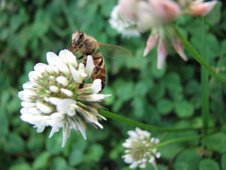
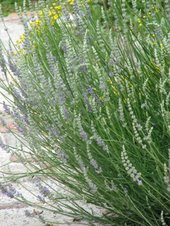
LP_2588.jpg)

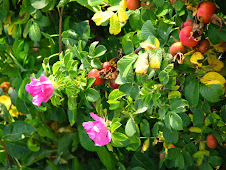
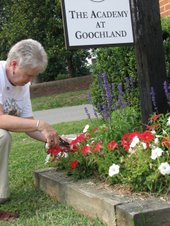


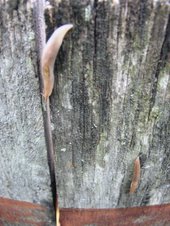
LP_2126.jpg)
LP_2122.jpg)
